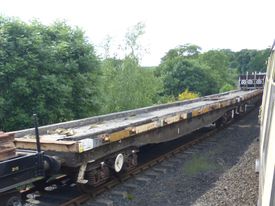BR 'Parr' Bogie Rail Wagons
| BR 'Parr' Bogie Rail Wagons | |
|---|---|
 DC967577 (nearer) and DC967526 at Bewdley, June 2018 | |
| Built By | Derby, converted at Shildon |
| Status | Operational |
| Number | See table |
| History | |
| Built | 1959-61 |
| Diagram | YL003A (design code) |
| Type | Bogie rail wagon (Borail) |
| Capacity | 50 tons |
| Telegraphic code | PARR |
| TOPS code | YQA |
| Brakes | Air braked |
| 1981-82 | Converted to PARR |
| 2017 | Arrived on the SVR |
Contents
Service
BR's Derby works[1] built 165 Bogie Rail Carriers, TOPS code BRV, in the early 1960s. 30 were built to diagram 1/482 and had a flat deck for carrying concrete beams, while the rest were built to diagram 1/483 and were equipped with five tall bolsters for carrying rail. Both designs had vacuum brakes, 'fish-belly' solebars (deeper between the bogies) and lacked any bodywork above floor height. Loads were secured using lashing rings mounted on brackets on the solebars. The 165 wagons were numbered B946065 to B946229[2], the B prefix indicating a BR era wagon used in revenue-earning service.
In 1981 Lot number 4012 was issued to upgrade 150 of the BRVs at Shildon works. Besides the modifications to the brakes and the fitting of new Y25C bogies, the body was altered to have 8in tall sides and ends, each side having 6 cutouts for strap tensioners. The lashing rings were removed but the brackets were left in situ, and six new bolsters were fitted. The rebuilt wagons were given new numbers 967500 to 967649, TOPS code BRA and design code BR006A.
The last BRAs were completed in January 1982. However by early 1983 the whole fleet had been transferred to Departmental use. DC prefixes were added to the wagon numbers and the wagons re-coded YLA (YLA-B) to design code YL003A. A further change of TOPS code to YQA took place in 1990 to avoid confusion with the YMA Salmon fleet[2].
Acquisition and use by the SVR
For many years, SVR P-Way trains used wagons fitted with vacuum brakes. In more recent times air-braked stock such as the 'Rudd' and 'Seacow' ballast wagons have been acquired, with the introduction of these two similarly fitted rail / sleeper carriers following this pattern.
The Traffic Notice for 21 November 2017 showed a Class 66 locomotive was to bring two wagons from Bescot. The move was cancelled due to no DBS Cargo driver being available. They were finally delivered on 14 December 2017 by locomotive 66066 and tripped to Bewdley by local arrangement using visiting locomotive 33108, which was in use on engineers' trains.
Details of the two wagons are as follows:
| Number | Originally built | Converted | Notes |
|---|---|---|---|
| DC967526 | Derby, 1959-61 | Shildon, 1981-2 | |
| DC967577 | Derby, 1959-61 | Shildon, 1981-2 |
Gallery
See also
References
- ↑ Paul Bartlett photos
- ↑ 2.0 2.1 LTSV Wagon information 16 March 2010 (retrieved 16 December 2017)

